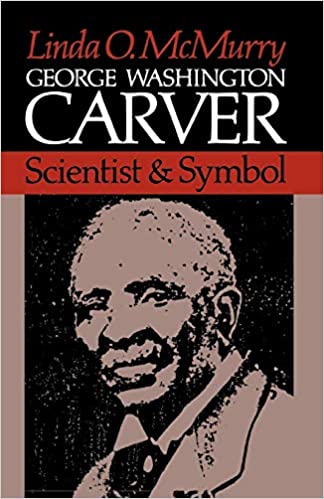|
The man known as "The Peanut Man" was a mystic, healer, agricultural scientist, chemist, educator, humanitarian, and artist to name a few attributes. In other words, this dignified and humble man named George Washington Carver was much more than just "The Peanut Man." I have been absolutely fascinated with him since I read about him in a book called, "The Secret Life of Plants" which is also the title of a documentary by Peter Thompkins and Christopher Bird. I will discuss the lesser known facts about "Geo. Washington Carver" as he used to sign his name, with the desire that I will stimulate new interest in reading and researching more about this gentle giant who made great contributions to society just after the abolishment of slavery in the U .S. The Early YearsWhile the details of his early life are a bit sketchy, he recalled often in adult life that he was born "about 1864." His mother Mary and brother Jim were enslaved on a plantation owned by Moses Carver. Moses Carver was said to be "eclectic," had a way with animals, and for years was opposed to slavery refusing to purchase any. After his farm began to have higher yields and his children and extended family moved away however, he went to a neighbor and purchased his first enslaved woman named Mary. During Carver's infancy, his mother was kidnapped and never returned by KKK "Night Riders." Carver's father was thought to be an enslaved man from a neighbor's plantation who was killed from an accident with a piece of farm equipment soon after he was born. . Due to these unfortunate circumstances, Carver doesn't have much recollection of his parents at all. The rest of Carver's background story does not fit conveniently into the atypical slave narratives of the period partially due to the many childhood illnesses he suffered, the mindset of his owners, and the aftermath of the Emancipation Proclamation. For example,
One morning in 1879, (Carver was about age 15), he saw a man lynched in the woods near his home. Immediately after, he decided to leave town from the horror and attain the answers to his persistent questions. Carver was curious about nature and wandered from home to home looking for answers. The book, "George Washington Carver Scientist & Symbol" by Linda O. McMurry. In the author of this post's opinion that this book is the most comprehensive of his life and the definitive text reference. I've created "Diagram 1: Timeline of Events in George Washington Carver's Life" based on that book. When I think about the age that Carver first went out on his own and his accomplishments in the hostile environment that America had created through slavery, Carver's courageousness was astounding. He seemed internally wired to search for the truth and unwavering in his quest. He didn't know where he was going nor who he would meet when he arrived. He befriended complete strangers and quickly earned their trust while in most cases agreeing to do household chores in exchange for room and board. How many people do you know today would allow a complete stranger without any references stay in your home? And with this uncertainty in front of him, he still moved ahead with his goal of finding the truth. After leaving his birth home he stayed with 4 different families before taking out a loan in 1884 at the age of 20 to buy 2 lots of land. We have to keep reminding ourselves that this is taking place right in the aftermath of slavery when doing so by a Black man was unheard of. Because of the skills and determination he gained along the way, 10 months after purchase for $100, he was able to sell at $500, a 5-fold gain. Even by today's standards, this is a fantastic feat. Carver then journeyed on again staying with families, saving money and working as a clerk in 1884. He later applied to college and moved to Highland, KS but was rejected due to their racist discrimination practices. His next stop was in Wess County, KS where he utilized the Homestead Act and claimed 160 acres of land. The Act allowed him to stay on the land for 5 years and build a home from the ground up out of sod in 1887. It wasn't until 1888 that he enrolled at Simpson College after the encouragement of the Midholand family who recognized the special interest and internal drive in Carver. Carver's list of accomplishments prior to those that he became famous for are mind boggling. This is proof positive that hard work pays off. He was persistent and consistent throughout his life. When storms came, he marched ahead with what he had. He also had a very devoted spiritual life. Every morning since childhood he would walk out in the woods around 4:00am and commune with nature. He would later say that the flowers would talk to him. Pictures of him always show a flower inside the lapel of his suit. Here is a prayer from a letter he wrote in 1941: "I indulge in very little lip service, but ask the Great Creator silently daily, and often many times per day to permit me to speak to Him through the three great Kingdoms of the world, which He has created, viz. - the animal, mineral and vegetable Kingdoms; their relations to each other, to us, our relations to them and the Great God who made all of us. I ask Him daily and often momently to give me wisdom, understanding and bodily strength to do His will, hence I am asking and receiving all the time." As an Art, Literature and music student at Simpson College he made many friends and kept high grades (3.2 and above) especially in his favorite subjects. He participated in the Debate, German and Art clubs as well. Though he excelled in whatever he put his mind to, it was soon time for him to move on again. Miss Etta Budd, one of his Art teachers saw his intellectual potential and counselled him to transfer to Iowa State University due to his interest in Botany and Agriculture. Her father was on faculty there and she thought that a career in a scientific field would provide personal security and sustain him economically. Carver also reasoned that this career move would allow him to be more of a benefit to "to his people," Black people. And the rest, we could say at this point is history. Iowa State proved to be the best match for his talents. The faculty in the Agriculture Department were the best in the industry and later worked for the government as US Secretaries of Agriculture. Carver focused on the study of mushrooms and grafting plants. His Master's Thesis was called, " Plants as Modified by Man." On the heels of his post-graduate work as an Ames faculty member, Carver received a letter that would change the course of his life. Booker T. Washington a well respected Black leader and educator invited Carver to join the faculty at a school named Tuskegee Normal and Industrial Institute that he founded in 1881. He stated that he wanted to establish an Agricultural Department and would like him to head it. This request seemed to fulfill his longstanding desire to help Black people. Though he had received better financial offers elsewhere, he recognized the value he cold bring for greater good. It is this part of Carver's journey that I appreciate most. At a certain point we have to ask ourselves what makes us happiest and know that money alone can not buy happiness. Others have said of Carver that he never chased after money. He was a man of high character, humility, and substance. For example, his attire was thought of as frumpy, and unstylish. He would reply paraphrasing, "if they want a suit I will send some clothes, if they want the information, then I will come."[1] The full collection of bulletins can be found in the too books listed above, "George Washington Carver Complete Works" v1, and v2 Carver went on to build from scratch his own laboratory, take on students and plant crops for experimentation. He wrote over 30 bulletins to document his findings. His main goal was to educate the newly freed enslaved men and women who were now share croppers. He wanted at his base to share ideas that would have a direct impact on the quality of life. As an example, Bulletin No. 38 is called, "How the Farmer can Save His Sweet Potatoes." has 31 recipes on how to prepare them, canning and as use for stock. The bulletins are written in plain speak so that the everyday farmer would understand them. Several were so popular that he had to re-print them. "Education is the key to unlock the golden door of freedom." - George Washington CarverHis title as, "The Peanut Man" was pinned to him after his presentation at a 1921 House Ways and Means Committee meeting. Carver was called as an expert witness on a pending bill proposing a tariff on the peanut. Though he was scheduled to speak for only 10 minutes, he impressed the senators so much that his time was extended up to an hour. Carver shared industrial uses for crops which wasn't popular at the time and gave practical suggestions for the land that was overly farmed in cotton. He espoused that cotton revitalized the soil with needed nutrients and could be used in production of non-food items. The complete transcript of his speech is in, "George Washington Carver, In His Own Words," edited by Gary Kremer. He shared peanut milk, chocolate covered peanuts, and buttermilk to name a few. They were wowed and he won the tariff, and fame. 8 Fun Facts about George Washington Carver
Books on George Washington Carver for KidsMore books on Carver here. Books on George Washington Carver for Adults# 1 Recommendation George Washington Carver - Scientist and Symbol by Linda McMurry Additional References George Washington Carver In His Own Words, Edited by Gary R. Kremer More books on Carver here I do appreciate you reading to the end of this post and hope you will consider ordering your books from us. If there is a title you do not see on our website, please send an email to: [email protected]
Comments are closed.
|
AUDIOBOOKSMERCHGIFTSjoin email listACADEMIC BOOKSblog Author/
|
- Store
- Blog
- AUDIO BOOKS
- EBOOKS
- SEARCH
- Welcome
- GoFundMe
- TUCC
- Events
- READING GUIDE
- AUTHOR INFORMATION
- ARTIST BIO/PRICE
- NNEDI OKORAFOR BOOKS
- PODCAST
- LARUE'S HAND IN CLAY
- About Us
- FREQUENTLY ASKED QUESTIONS
- BOOK FAIR /SCHOOLS / CLUBS
- Photo Gallery
- EJP BOOK DRIVE
- Videos
- Newsletter/Articles
- Archives
- External Links
- Afriware Statement on COVID-19
- GREATER LAKES
- Afriware Merchandise
- AFFILIATE INFO
- SEBRON GRANT ART DESIGNS
- Mother's Day Bundles
- CARTOON
- ROBOTS
- STEM
AFRIWARE BOOKS CO. A COMMUNITY BOOKSTORE SERVING:
|
|
Melrose Park, IL
|
|
,AFRIWARE BOOKS, CO,
1033 SOUTH BOULEVARD, OAK PARK, IL 60302 708-223-8081 ONLINE SUPPORT: Thurs-Fri. 4-6pm Sat. 12-2pm, IN PERSON EVENTS: afriwarebooks.com/events |
Want to try a great website builder, try Weebly at: https://www.weebly.com/r/9SAD4V















 RSS Feed
RSS Feed


